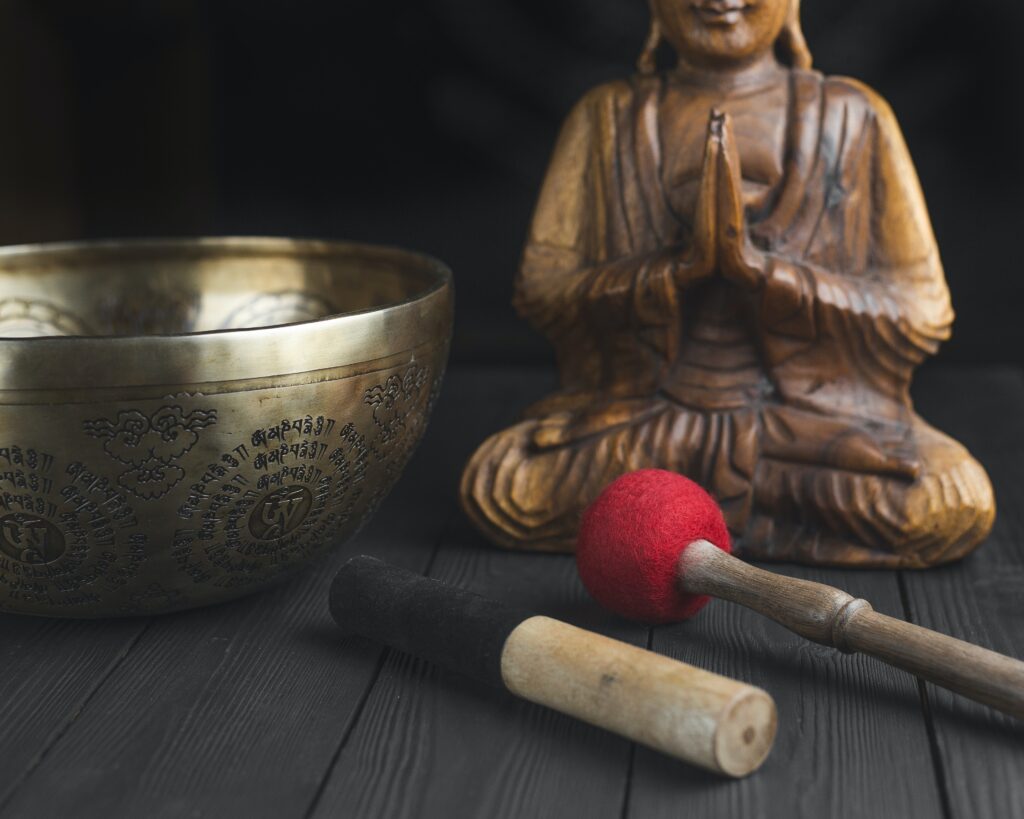The concept of Sankalpa, meaning “intention” in Sanskrit, is a fundamental aspect of yoga, particularly seen in the practice of yoga nidra.
A Sankalpa is not merely a goal but an expression of a deep, heartfelt commitment to achieving one’s highest aspirations. Unlike common resolutions that are often specific and outcome-focused, a Sankalpa aligns one’s mental willpower and deep spiritual resolve, making it a vow that supports personal growth and spiritual enlightenment.
Its benefits in everyday life are profound; it serves as a guide to live more consciously, enabling us to maintain focus and act in alignment with our true desires and values. Thus, integrating a Sankalpa into one’s yoga practice or meditation routine can enhance mental clarity, emotional stability, and overall life satisfaction.
Table of Contents
Toggle
What is a Sankalpa?
Sankalpa is deeply rooted in yogic philosophy, where it serves as a bridge connecting the practitioner’s present state with their ultimate spiritual goals. A Sankalpa is used to harness the mind’s intent during meditation and yoga nidra, setting a personally resonant intention at the commencement of the practice.
This intention is not about asking for what one wishes to possess, but rather about aligning with the essence of what one truly seeks to be, facilitating a transformation that aligns with one’s dharma, one’s life purpose.
The power of a Sankalpa lies in its ability to penetrate the subconscious mind, which is a vast reservoir of unacknowledged desires, memories, and drives. By framing a Sankalpa in the present tense, as if it is already happening, it acts as a seed planted deep within the subconscious. This method bypasses the rational mind, which often harbors doubts and disbeliefs, allowing the Sankalpa to foster profound changes from within.
Over time, as the Sankalpa is mentally repeated, it reshapes the subconscious, aligning it with the practitioner’s conscious desires and spiritual aspirations.
Difference Between a Goal and a Sankalpa
Ordinary goals are typically oriented towards external achievements and are often defined by specific metrics, such as gaining a promotion, losing weight, or buying a house. These goals rely heavily on the ego and are susceptible to fluctuations in motivation and external circumstances.
In contrast, a Sankalpa transcends this by focusing on the essence of one’s being and the intrinsic values that define a fulfilled life. It is not about achieving something external but about becoming a version of oneself that is most aligned with inner truth.
Thus, a Sankalpa is enduring, serving as a constant guide through the ups and downs of life rather than a temporary target to be achieved or discarded.

Elements of a Sankalpa
Clarity and Simplicity
A Sankalpa should be clear and simple, conveying its essence in as few words as possible. This clarity helps keep the mind focused and makes the intention easy to recall. For example, instead of a complex statement, a simple Sankalpa might be “I am at peace” or “I choose contentment over anxiety.” These are straightforward and direct, leaving no room for misinterpretation.
Present Tense and Positivity
Formulating your Sankalpa in the present tense is crucial as it implies that the change you wish to embody is already occurring. This method is a powerful psychological tool that helps you “live into” your intention, making the subconscious mind a partner in manifesting this new reality. Additionally, framing the Sankalpa positively avoids focusing on what you lack or what you are trying to avoid. Positive affirmations reinforce your capability to change and grow, such as “I am whole” instead of “I am not broken.”
Authenticity and Personal Connection
Your Sankalpa should resonate deeply with your personal values and true self. It should reflect your highest aspirations and innermost desires, not what others expect of you or what you think you should want. This authenticity ensures that the Sankalpa is not only meaningful but also motivating. When a Sankalpa truly reflects your inner truth, it connects with your heart, not just your mind, making it a powerful catalyst for transformation. This connection is what gives the Sankalpa its strength to influence profound changes in your attitude, behavior, and overall approach to life.
5 Steps to Create Your Sankalpa

1. Deep Reflection
The first critical step in formulating a Sankalpa that truly aligns with your innermost desires and life’s purpose is deep reflection. Deep reflection is where you dig deep into your own psyche, uncovering true desires and core values. This phase requires quiet, sustained contemplation and can be facilitated through various introspective techniques.
Journaling can be a powerful tool for self-discovery. Start by writing freely about your aspirations, fears, and current life situation. Use prompts such as “What brings me joy?”, “What am I grateful for?”, or “What does my ideal day look like?” This exercise is not about crafting perfect sentences but about letting your thoughts flow, which can reveal your deeper desires and the themes that you wish to focus on in your Sankalpa.
Meditation helps calm the mind and brings you into a state of receptive silence, where deeper insights can surface. Begin with a simple mindfulness practice, focusing on your breath to achieve a state of mental clarity. As you meditate, pose open-ended questions to yourself like, “What do I truly want?” or “Who am I becoming?” Allow thoughts and feelings to arise naturally, observing them without attachment.
The goal of deep reflection is to emerge with a clearer understanding of your true self and the intentions that are most aligned with your inner truth.
2. Identifying Core Desires
The next step in creating your Sankalpa is to identify your core desires. This involves differentiating between surface desires—those that are fleeting and often material—and deeper, true desires that align with your inner values and long-term fulfillment.
To start this process, review the insights and thoughts you’ve gathered from your initial reflections. Look for patterns or recurring themes that might indicate deeper aspirations. Surface desires often manifest as wants that are influenced by external factors, such as societal expectations or immediate gratification. These might include desires for a new job, more money, or physical possessions. While these can provide temporary happiness, they often don’t lead to long-lasting fulfillment.
Deeper desires, however, are connected to the essence of who you are. These desires reflect what you need to feel truly fulfilled and at peace. They are often linked to personal growth, relationships, spiritual well-being, and contributing to others. For example, a deeper desire might be to develop a sense of inner peace, to be more compassionate towards others, or to live a more authentic life.
To effectively identify your core desires, try asking “Why?” for each surface desire to uncover underlying motives. For instance, if you desire a new job, ask yourself why this is important. You might discover it’s not the job itself but the need for a sense of accomplishment or to make a meaningful contribution that is driving your desire.

3. Formulation
Once you have identified your core desires through introspection, the next step is the actual crafting of your Sankalpa. Crafting a Sankalpa phrase involves distilling your deep desires into a concise, clear, and positive statement that encapsulates your intentions and affirms your commitment to your inner goals.
Your Sankalpa should feel like a natural extension of your being, something that resonates deeply and personally.
Examples of Sankalpa phrases might include “I am complete and grateful for my life,” “I am a loving and compassionate presence in the world,” “I embrace each moment with joy,” or “I am strong, healthy, and wise.”
Once your Sankalpa is formulated, start integrating it into your daily routine. You can repeat it during meditation, upon waking, before going to bed, or in any moment of stress or uncertainty. The regular affirmation of your Sankalpa helps to solidify it in your subconscious, making it a powerful driving force in your life.
Remember that as you grow and change, your Sankalpa may evolve as well. It’s important to periodically reflect on your Sankalpa and feel if it still resonates. If your circumstances or insights shift, adjust your Sankalpa accordingly so it continues to align with your true self.
4. Refinement
Adjusting your Sankalpa over time is crucial as it must evolve with your personal growth and changes in life circumstances. A Sankalpa that once felt aligning might need tweaking to match new insights or different phases of life.
Set a regular interval for reviewing your Sankalpa, such as every few months or in alignment with significant life events. During these times, assess whether your Sankalpa still resonates deeply with your desires and current life direction.
Engage in reflective practices to explore how well your current Sankalpa aligns with your feelings and experiences. Consider if there have been changes in what feels important to you or if your Sankalpa still evokes a strong emotional response. If it feels like just another phrase, it might be time to adjust.
Adjust your Sankalpa if you find it no longer fits your current aspirations or if you’ve achieved the state of mind it was intended to cultivate. Crafting a new Sankalpa or tweaking the existing one to better reflect your current path can reinvigorate your practice.
Stay open to the possibility that as you change, your deepest desires might also shift. The refinement process is not about discarding your previous intentions but rather about refining them to enhance their relevance and impact.

5. Integration
Integrating your Sankalpa into your yoga and meditation practice enhances its power and allows it to seep deeply into your subconscious, aiding in actualizing your intentions.
Using Sankalpa in Yoga Nidra is a traditional and highly effective approach. Yoga Nidra, a form of guided meditation also known as yogic sleep, provides a unique state of consciousness between waking and sleeping that is ideal for planting the seeds of your Sankalpa.
During Yoga Nidra, after the body and mind are fully relaxed, you state your Sankalpa clearly and with conviction, typically three times, to impress it upon the subconscious mind deeply.
Repeat your Sankalpa during specific times to strengthen its influence—such as at the beginning and end of your yoga practice, during meditation, first thing in the morning upon waking, and last thing at night before falling asleep. The regular articulation of your Sankalpa helps solidify its presence in your mind, making it a living part of your daily routine.
Common Pitfalls
Setting overambitious Sankalpas is a common pitfall. While it’s important to aim for meaningful change, goals that are too large or broad can become overwhelming and unattainable. This can lead to frustration and a sense of failure, which might discourage you from continuing with your practice.
To avoid this, make sure your Sankalpa is realistic and achievable. It should challenge you, but also be something you can realistically integrate and embody within your current life circumstances.
Lack of consistency or forgetfulness in practicing or recalling your Sankalpa can also undermine its potential. A Sankalpa needs to be engaged with regularly to truly embed it into your subconscious and make it a living part of your psyche.
Handling discouragement is another crucial aspect of working with a Sankalpa. It’s natural to face periods where it feels like little or no progress is being made, or where circumstances challenge your resolve. In these times, it’s important to stay flexible and patient with yourself.
Reflect on the nature of the setbacks and see if they indicate a need to refine your Sankalpa. Remember that every step back is an opportunity to learn and grow, not a sign of failure.













